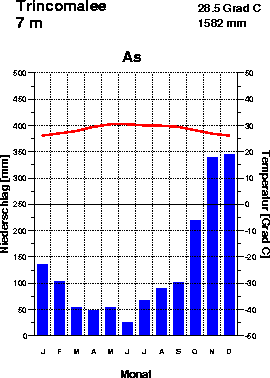|
TRINCOMALEE
The region's largest city stands on an isthmus with two deep
bays to seaward and a fine natural Inner Harbour to the west. It naturally attracted the attention of European colonial powers
as early as the first quarter of the 17th century, changing hands repeatedly among the Portuguese, the Dutch, the French and
the British in a series of side-shows to the European wars of the 17th and 18th centuries, before finally falling to a British
fleet in 1795. It remained one of the British Empire's most important ports in Asia, and from 1941-45 was the headquarters
of the Allied Southeast Asia commander. Lord Louis Mountbatten. Other distinguished British military men to have sojourned
here include Sir Arthur Wellesley (later the Duke of Wellington), who recuperated here in 1799 from fever caught while campaigning
against the French and their allies in southern India. In the middle of the Inner Harbour, connected to the isthmus by a narrow
causeway, is Powder Island, once a gunpowder magazine for the Royal Navy, but now occupied by the Sri Lankan defence force.
Fort Frederick
The northeast-pointing promontory which separates Dutch Bay from
Back Bay was fortified first by the Portuguese, then by their successors and finally by the British, who named it Fort Frederick.
It is now in the hands of the Sri Lankan military, so access is problematic. At the tip of the promontory is Swami Rock, where
a Hindu temple stood until being demolished by the Portuguese.
Trincomalee Beaches
Uppuveli is the most conveniently located beach for those staying in Trincomalee, only 6km (4 miles) north of the city
center and accessible by taxi or three-wheeler.Nilaveli is a 4km (2.5-mile) stretch of beach which starts about 16km (10 miles)
north of Trincomalee and which, until the troubles, was poised to become one of the east coast's first mid-range resort areas.
Trincomalee Fort
The Portuguese built a fort at Trincomalee in 1624,
at the base of a high rock, which is called Swami Rock today. On the top of this rock was a famous temple, the 'Pagoda of
a thousand pillars', which the Portuguese destroyed. The stones were used to build the fort. In 1639 the Dutch attacked it
with a fleet of 12 ships under Admiral Westerwold, and captured it. The Portuguese fort was rebuilt but later abandoned. Only
in 1665 a new fort was built in its place, when it became clear the British and the French were interested in this east coast
harbour. In 1672, the year when the Dutch Republic was attacked by France, Brittain, and two German states, the French captured
Trincomalee. They sent an embassy to Raja Singha in Kandy, who allowed them to occupy Trincomalee and Batticaloa. Van Goens
soon sent a fleet however, which trapped the French in their fort with no food or water. Four months later they were forced
to leave.

|

